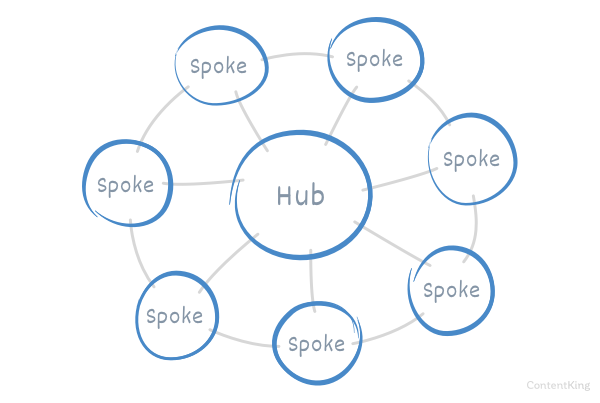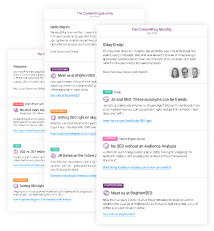I think the hub and spoke model is the future of content structuring. When I was first introduced to this concept several years ago, I thought it made so much sense, intuitively, and I don’t think it is going anywhere.
I believe common sense dictates that a website with a singular article on a topic, won’t likely outrank a site with multiple articles on that same topic. Google has confirmed the importance of E-A-T, and I think creating strategic content clusters is a great way to demonstrate that you are an authority on a particular subject matter.
Hi Amy! Can you tell us a little about yourself?
Sure! I have been involved in SEO since 2011. I got my start working as a link builder for an agency and eventually moved into a more holistic SEO role in 2017, specializing in content strategy and technical SEO.
The majority of my career has been focused on SEO for lead generation niches including education and healthcare. Currently, I am focused on e-commerce SEO, leading global SEO strategy for Tupperware Brands (opens in a new tab).
Can you describe what your role at Tupperware Brands entails?
My job is very exciting, as I am the one and only SEO specialist for Tupperware Brands! I oversee global SEO strategy for the various markets across Tupperware, making sure their websites are as optimized as possible and rank for important business terms.
This includes things such as performing keyword research for new product launches, reviewing website copy to ensure it is search-friendly, as well as performing technical audits & making recommendations on how to grow organic visibility.
What do you think is the most promising SEO strategy for 2020?
I think it is most important to keep the user at the center of everything you do. I think too many people get caught up in trying to please Google, and Google is constantly evolving to try to provide the best experience for the user.
I think by focusing on optimizing for the user, you essentially cut out the “middle man”, and produce good quality content that is written for humans, not search engines.
Though there are certain things we have to do only for Google, such as submitting an XML sitemap (opens in a new tab) and robots.txt file (opens in a new tab), I think keeping content strategy focused on the end-user in mind, will ultimately stand the test of time.
Who do you draw inspiration from when it comes to SEO strategies?
There are many great SEO minds out there, but 3 of my favorites are Aleyda Solis (opens in a new tab), Marie Haynes (opens in a new tab), and Bruce Clay (opens in a new tab).
I often turn to Aleyda Solis when seeking advice on a technical SEO problem. Her hreflang implementation guide (opens in a new tab) helped me tremendously when dealing with multi language store views for the Tupperware US & Canada websites.
Marie Haynes is my go-to person for advice & information on Google algorithm updates. Hearing her speak at Pubcon 2019 (opens in a new tab) was the highlight of the conference for me. Knowing she has read Google’s Quality Rater Guidelines (opens in a new tab) cover to cover multiple times is incredible and she is definitely someone I look up to.
Bruce Clay taught me everything I know about website silos and site architecture. I was incredibly lucky to have a 6-month consultancy with one of his analysts several years ago, and it was game-changing. His article, “SEO Siloing: How to build a website silo architecture (opens in a new tab)” is the basis for my current views on creating silos and the “hub & spoke” model of content strategy.
What’s the difference between content silos and hub pages, and how does pillar content factor into this?
Content silos are essentially clusters of content (spokes) all centered around the same parent (hub) topic. There are 2 types of silos, physical silos, and virtual silos.
Physical silos use URL structure to house related articles under a single directory. For example, if I created a website about different medical conditions, I may have an overview (hub) page on COVID-19 ex. www.mysite.com/covid19 and then create additional articles (spokes) on symptoms, testing, and treatment that all live off of that hub folder.
For example:
www.mysite.com/covid19/symptomswww.mysite.com/covid19/testingwww.mysite.com/covid19/treatment
Virtual silos use internal links to establish connections to a parent topic. For example, if all 3 spoke pages listed above linked back to the hub page on COVID-19, that would signal to Google and to the user that the spoke pages are all topically related to the hub (parent) page. In turn, the hub page should link out to each spoke (child) page.

By arranging content into silos, it helps both Google and the user understand that you are an expert in a particular subject area as having multiple articles around the same hub topic makes you appear more authoritative than if you had a one-off article on that topic hidden somewhere in your blog.
I know there may be some debate about this, but as far as I am concerned, pillar pages and hub pages are one and the same. These are the high-level overview pages that link out to a number of relevant subtopics.
Pillar pages are sometimes considered to be more thorough than hub pages, but I think a good hub page is more than just a table of contents. It is a comprehensive overview page that links out to additional subpages focused on a particular topic such as symptoms or treatment in our example above.
You obviously care about content. Don't let changes to your carefully crafted hubs and spokes go unnoticed — be alerted immediately!
How do you determine what Hubs and Spokes to create?
I like to use a combination of keyword research (opens in a new tab) and common sense when determining what hubs and spokes to create. The hub should be the main topic you wish to write about and the spokes will be all of the supporting pages. Many keyword research tools such as Ahrefs and SEMrush do a good job of helping to suggest related topics.
SEMrush’s keyword magic tool by default provides broad match results for a particular keyword phrase. Scrolling through them will likely provide ideas for related topics to your seed topic. You can also filter by question-based queries related to your seed search term which is helpful in crafting spoke pages as well.
Likewise, ahrefs.com provides search suggestions as well as questions based on your seed query. Additionally, ahrefs.com also provides the parent topic for your query, which can be helpful in understanding if your keyword phrase would make a good parent (hub) topic, or if it is better suited for a supplementary (spoke) article.
Other tools such as Ubersuggest (opens in a new tab) and Answer the Public (opens in a new tab) can also help you research related long-tail variations of your search term as well.
Can you show an example of a Hub and Spokes model implementation you’re particularly proud of?
Yes! In a previous role, I was responsible for creating and building out the mental health section of The Recovery Village. Not only was the main ”mental health” landing page (opens in a new tab) a hub, but each mental health disorder had its own hub (overview) page and spoke pages on treatment, substance abuse, FAQs, and more.
I created a silo navigation with buttons in the right sidebar in addition to in-content links to keep users moving throughout the silo. The mental health disorder hubs and spokes were well crafted and as a result, much of the content produced within this website section ranked as a featured snippet shortly after publication.
What is the number one rule to keep in mind when you are implementing a new Hubs and Spokes architecture on a site?
Internal links are your friend! Internal linking is the key to making sure users (and Google) can effectively navigate your silos (hubs & spokes). You never want a spoke page to be orphaned, and want users to be able to find all pages of your silo with as few clicks as possible.
Remember, however, to be careful when linking outside of your silo, as you could risk the integrity of it by linking out to other non-related pages. As a best practice, only link outside of your silo when absolutely necessary and try to keep those links outside of your silo to other hub pages if possible. As linking from a spoke page of one silo, to a spoke page of another silo can dilute the themes of both.
Don't let changes to your internal links go unnoticed. Track everything, and be alerted when links are broken!
Are long pillar posts with all information on one page better than hub pages with additional spokes?
Not necessarily. I think it all depends on the topic and what the intent is behind the query that landed a user on your page.
Going back to the COVID-19 example from above, if someone is specifically looking for information on how to get tested, they may not want to read through a long-form piece of content that includes the history of COVID-19, statistics on current cases numbers, and treatment options, to find the information they are looking for.
However, if someone performs a general search for “coronavirus information”, it may be helpful for them to land on a comprehensive article about the disease that provides links to additional sub-topics that they may be interested in learning more on.
Can websites with a Hub and Spokes model rank well even in case their URL structure isn’t unified?
I think many factors go into ranking and URL structure isn’t necessarily a deal-breaker for sites that use virtual silos and internal linking well, however, I’ve had great success with using a unified URL structure as part of overall site architecture design.
I think bucketing related pages under a single parent folder helps Google better understand the relationship between the content, and I always recommend using physical silos (URL structure) in addition to virtual silos (internal linking) when creating content hubs and spokes.
Is trying to manage a multi-niche content platform a good idea?
As long as you utilize the hub and spoke model to organize your content, then, it can work just fine. For example, if you run a digital marketing company and provide different services including SEO and PPC You can create separate content clusters for each of the 2 services to help Google and the user understand the different niches.
How do you see the future of content structuring?
I think the hub and spoke model is the future of content structuring. When I was first introduced to this concept several years ago, I thought it made so much sense, intuitively, and I don’t think it is going anywhere.
I believe common sense dictates that a website with a singular article on a topic, won’t likely outrank a site with multiple articles on that same topic. Google has confirmed the importance of E-A-T, and I think creating strategic content clusters is a great way to demonstrate that you are an authority (opens in a new tab) on a particular subject matter.
If you could give our readers one tip on Hubs and Spokes, what would it be?
Don’t overthink it.
Overall, hub & spoke is not an overly complicated strategy, it’s a way of organizing content so that related pages all focus back to a primary topic. It’s also not an entirely new concept. Think about the purpose of blog categories, for example. They essentially group together all articles on a particular topic into one singular bucket.
The hub & spoke model takes it one step further by providing an overview or parent page that links out to all of its child pages. It encourages us to fully flesh out our parent topic idea by providing additional articles on relevant subtopics for the reader.



